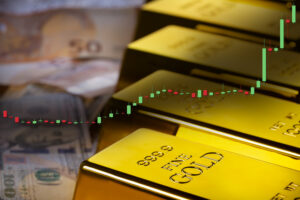What is the Role of Gold in 2020?
The comments below are an edited and abridged synopsis of an article by Jim Iuorio
Gold has rallied 30% in 2020 and is up a staggering 600% since 2000. Meanwhile, the US dollar is down 10% against the dollar index since March 23. Not coincidentally, March 23 was the day the Fed announced its plan for unlimited QE in response to the economic collapse.

Is gold’s rally simply a response to the perception of the currency policies? Veteran trader Jack Bouroudjian called the current environment “the perfect storm for gold due to the Fed and the economy.”
CME Group senior economist Eric Norland noted that “gold is a monetary phenomenon and reflects both Fed and other global central bank policies.” Jim says that gold’s buoyancy is reflecting a couple of things.
The first is Fed policy. In August, the Fed committed to pursuing 2% inflation per year. This comes after years of the Fed expressing frustration over its inability to spark inflation. The metals market appears to be respecting this new commitment. The second is that the federal government has begun expanding budget deficits, and the national debt is at unthinkable levels. In January 2017, it was $20 trillion. It’s now $27 trillion.
Historically, currency markets frown on elevated debt loads. The dollar index has been the measure of dollar strength for many years, despite serious flaws. The euro holds 56% of the weighting in the index, and the yen 14%. So 70% is made up of other currencies that represent countries that maintain high debt loads. This narrow focus gives an obfuscated picture of dollar strength.
The Swiss franc, with more reasonable debt loads, is up 90% against the dollar since 2000. It may take a combination of measures to ascertain the dollar’s true value, and the metals market, particularly gold, should be front and center.
Gold is often a market worth watching. With the uncertainties seen in 2020 and the policy responses to that uncertainty, that is especially true now.
